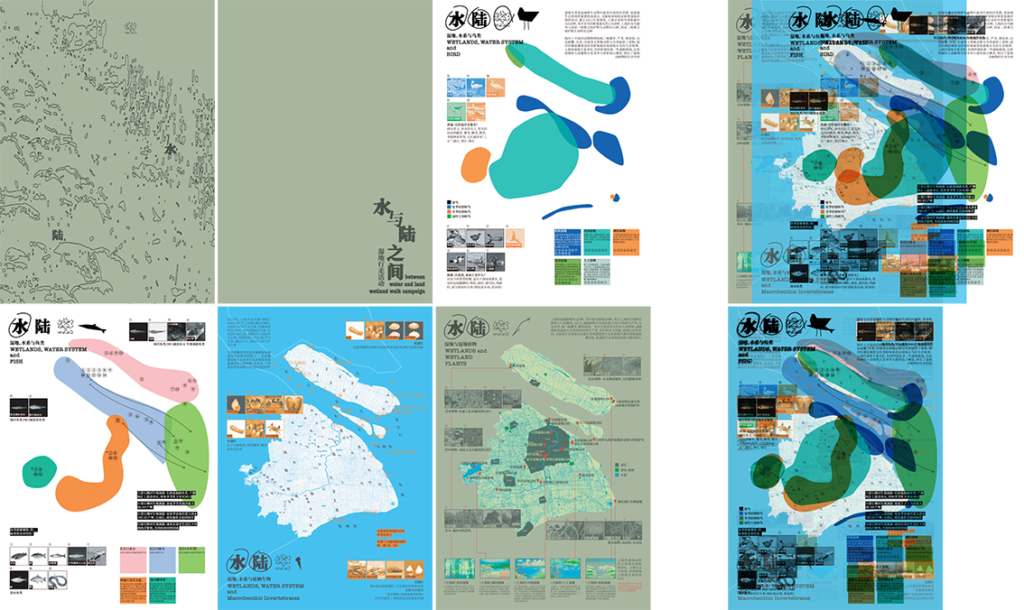湿地行走活动——视觉与印刷媒体设计
Wetland walk campaign – visual and print media design
The project aims to convey the ecological content that wetlands are the junction of water and land, the junction of two ecosystems where the exchange of various energies and exchanges is more active. Wetland ecosystems have a rich hierarchy of organisms distributed in the rich spatial layers of the wetland, such as water, soil and air, with birds, fish, small animals, and plants distributed among them and exchanging energy and information in different material spaces. 该项目旨在传达这样的生态内容:湿地是水与陆地的交界处,是两个生态系统的交界处,在这里,各种能量和交换的交流更加活跃。湿地生态系统有丰富的生物层次,分布在湿地丰富的空间层次中,如水、土壤和空气,鸟类、鱼类、小型动物、植物分布其间并在不同的物质空间中交换能量和信息。

Shanghai is a city rich in wetlands, and with World Wetlands Day just around the corner, I designed the “Between Water and Land” wetland walk campaign, and through the visually distinctive, portable, and easy-to-read event visual and print media design, I aimed to educate wetland visitors about the ecological content of the above, and to motivate them to continue walking, exploring, and communicating about the species present in their wetlands and other wetlands in Shanghai’s wetland system. 上海是一个湿地丰富的城市,在“世界湿地日”即将到来之际,我设计了“水与陆之间”湿地行走活动,并通过视觉鲜明便携易读的活动视觉与印刷品设计,旨在让湿地的游客们了解到以上的生态内容,并促使他们继续行走、探索和交流所在湿地和上海湿地系统中其他湿地存在的物种。
The project presents the ecological content through visual system design and information visualisation design, and communicates it to the public through the medium of printed materials. The printed materials are divided into two parts: the “Layers of wetlands” poster and the “Wetland Walk Guidebook” booklet, which is designed in conjunction with the project scenarios. The “Layers of Wetlands” poster consists of four informative posters with different and interrelated contents and materials, presenting wetland plants, wetland benthos, wetland fish and wetland birds in the Shanghai wetland system, corresponding to thin environmental paper, sulphuric acid paper and PVC (for fish and birds), respectively, with the range of the species expanding in turn. The posters are hung in this order in an overlapping format and can be read individually or overlapped to see which different types of species are distributed in the same area by matching the information on the different posters. The “Walking Guide to Wetlands” booklet will be different for each wetland, as it presents information on the species found in the wetland. The booklet will contain species that will be found in the situated wetland, and will be designed to entice the reader to read and continue exploring the area through the use of a combination of photographic and graphic visuals. The booklets will be available in both ‘scratch-off’ and ‘no scratch-off’ versions, with the latter being the more suitable version. The booklet is thin and flexible enough for visitors to pick up and carry with them, while the ‘scratch-off’ version allows them to explore the wetland species while scratching to see what they might be seeing. 项目通过视觉系统设计和信息可视化设计的方式呈现生态内容,并以印刷物为媒介向公众传达。印刷物分为两部分:“湿地层次”海报部分,和结合项目场景设计的“湿地行走指南”小册子。“湿地层次”海报包含四张内容和材料各不相同又彼此联系的四张信息海报,分别呈现了上海湿地系统中的湿地植物、湿地底栖动物、湿地鱼类和湿地鸟类,分别对应薄型环保纸、硫酸纸和PVC(鱼类和鸟类),物种的活动范围依次扩大,海报按此顺序以重叠的形式悬挂,可以单独阅读,也可以重合起来看,将不同海报上的信息对应起来,能看到哪些不同类型的物种分布在同一区域。“湿地行走指南”小册子主要呈现所在湿地的物种信息,因此每个湿地的小册子都将是不同的,小册子中只放入将在所在湿地出现的以上四种类型的物种,通过摄影和图形结合的视觉设计吸引读者阅读和继续探索。小册子有“刮刮乐”版本和“无刮刮乐”版本,经测试后者更为适用。小册子薄而柔软,游客可以随手取走并随身携带,“刮刮乐”版本可以一边探索湿地物种一边刮开查看看到的生物可能是什么。



The same visual system is used for both parts of the printed materials. The visual system uses a natural colour scheme and typeface with hand-drawn lines and self-drawn abstract graphics to highlight its interactivity and uses the words “water, land and atmosphere” + hand-drawn circles to subtly express the complexity and intersectionality of the distribution of wetland species, while the main visual also includes a graphic design based on abstract graphics, which is derived from the photographs taken at the junction between land and water in the Jiangwan Wetland, and labelled with the words “Water, Land, Atmosphere” in the graphic, to illustrate the concepts of the visual system and its mode of viewing. 两部分印刷物都使用同一套视觉系统,该视觉系统使用了有自然气质的配色和字体,并加入手绘线条和自绘抽象图形凸显其可互动性,并用“水陆空”字样+手绘划圈的方式巧妙地表现湿地物种分布的复杂性和交叉性,主视觉还包括一份以抽象图形为主体的平面设计,图形抽象自在江湾湿地拍摄的水与陆交界的照片,并在图形中标注出“水、陆、空”,阐明视觉系统的概念和观看方式。
The project was prototyped and tested at the Jiangwan Wetland Bird Viewing Base, more details of the test are presented in the video, please feel free to watch it. The photography photos and video materials used in the project are from me and my fellow photographers I invited. 项目在新江湾湿地观鸟基地进行了原型测试,测试的更多细节在视频中有所呈现,欢迎观看。项目中使用的摄影照片、视频素材来自我和我邀请的摄影师同学。
